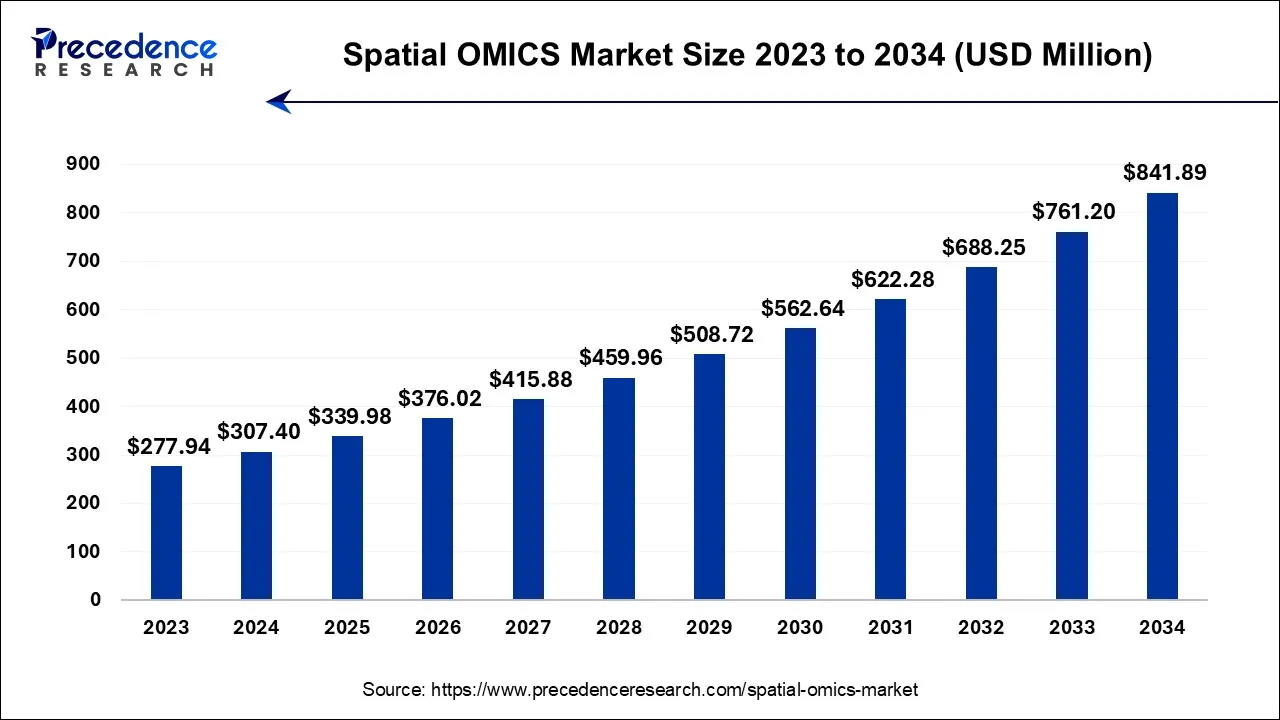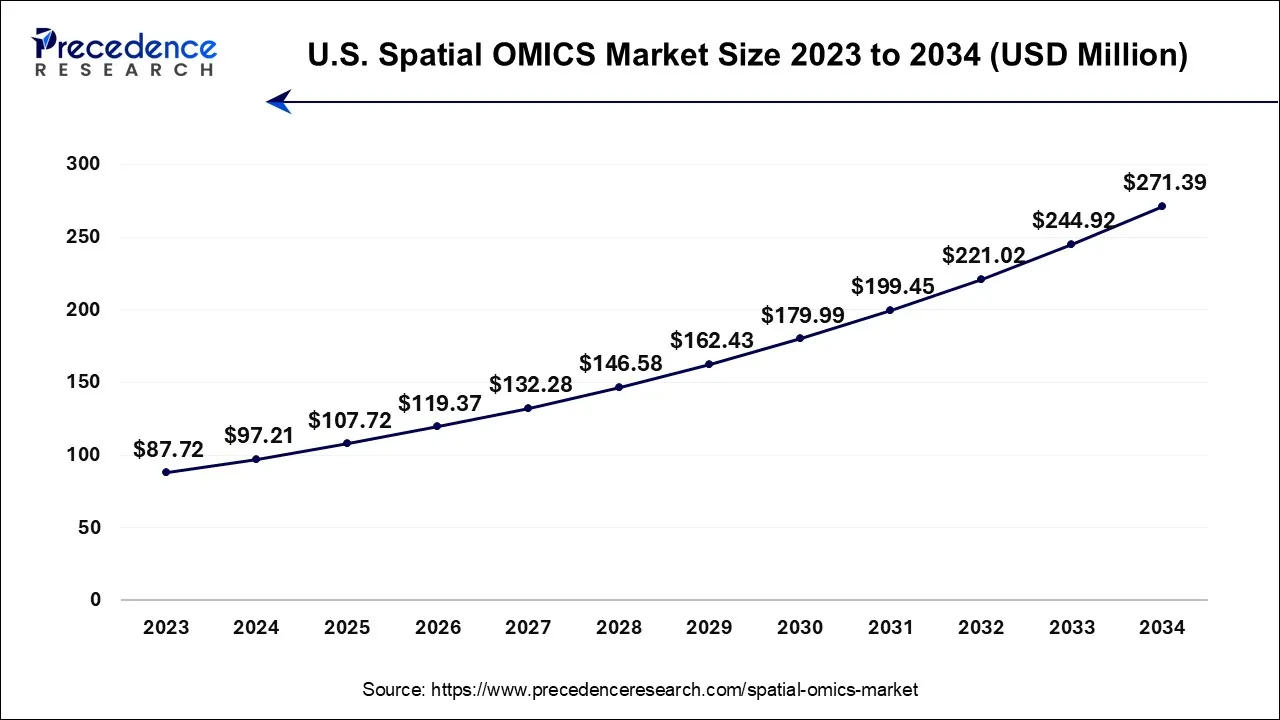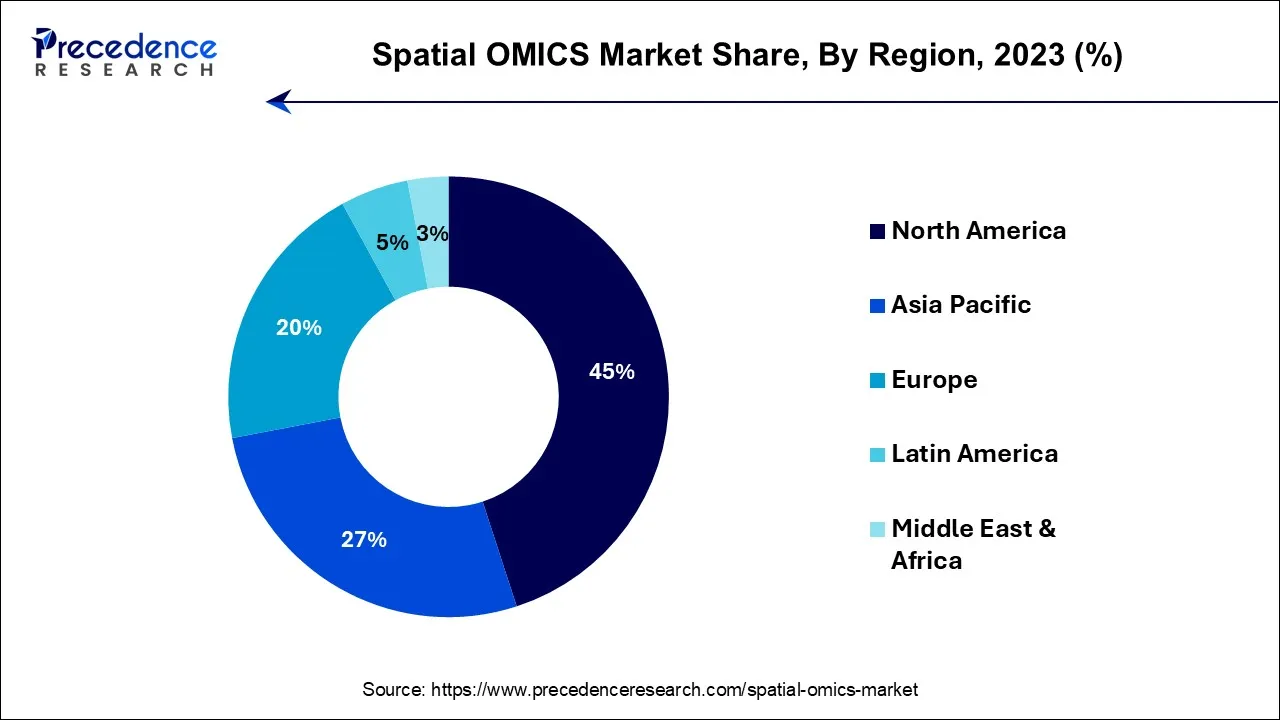List of Contents
Spatial OMICS Market Size and Forecast 2025 to 2034
The global spatial OMICS market market size was estimated at USD 307.40 million in 2024 and is predicted to increase from USD 339.98 million in 2025 to approximately USD 841.89 million by 2034, expanding at a CAGR of 10.6% from 2025 to 2034.

Spatial OMICS Market Key Takeaways
- North America contributed more than 45% of revenue share in 2024.
- Asia-Pacific region is estimated to expand the fastest CAGR between 2025 and 2034.
- By Application, the Diagnostics segment has held the largest market share of 39% in 2024.
- By Application, the Translation Research segment is anticipated to grow at a remarkable CAGR of 12.8% between 2025 and 2034.
- By Solution Type, the Instruments segment generated over 42% of revenue share in 2024.
- By Solution Type, the Software segment is expected to expand at the fastest CAGR over the projected period.
- By Sample, the DNA segment generated over 52% of revenue share in 2024.
- By Sample, the RNA segment is expected to expand at the fastest CAGR over the projected period.
- By End-user, the Biopharmaceutical & Biotechnological Companies segment had the largest market share of 48% in 2024.
- By End-user, the Academic and Research Institutions segment is expected to expand at the fastest CAGR over the projected period.
U.S. Spatial OMICS Market Size and Growth 2025 to 2034
The U.S. spatial OMICS market size is accounted for USD 97.21 million in 2024 and is projected to be worth around USD 271.39 million by 2034, poised to grow at a CAGR of 10.8% from 2025 to 2034.

North America has held the largest revenue share of 45% in 2024. The North American spatial OMICS market showcases a trend of substantial growth driven by extensive research and development initiatives. Leading academic institutions, biotechnology companies, and pharmaceutical firms are heavily investing in this technology, particularly in precision diagnostics and drug discovery. The region benefits from a robust infrastructure for data analytics and interdisciplinary collaborations, further accelerating advancements in spatial OMICS applications.

Europe is estimated to observe the fastest expansion. In Europe, the spatial OMICS market is characterized by a strong emphasis on standardization and regulatory compliance. The region is focusing on developing standardized protocols for data collection and analysis, ensuring data accuracy and reproducibility. This commitment to standardization is crucial for fostering trust in spatial OMICS data and its adoption in clinical and regulatory settings. Additionally, European researchers are actively exploring applications in neuroscience and cancer research, contributing to the market's steady growth.
In the Asia-Pacific region, the spatial OMICS market is experiencing rapid growth, driven by increasing investments in healthcare and life sciences research. This dynamic region is witnessing a surge in precision diagnostics, biomarker identification, and applications in fields like agriculture. Governments and research institutions are actively collaborating to harness the potential of spatial OMICS, propelling advancements in disease understanding and treatment strategies.
Market Overview
- The spatial OMICS market encompasses a cutting-edge field that integrates spatial, or location-specific, information with OMICS technologies like genomics and proteomics. This combination allows for the precise mapping of molecular and cellular data within a specific tissue or environment. The Spatial OMICS Market plays a pivotal role in comprehending intricate biological systems, deciphering the underlying mechanisms of diseases, and propelling the field of precision medicine.
- Researchers leverage this technology to meticulously explore the spatial arrangement of biomolecules and cells within tissues, facilitating profound insights into areas such as cancer, neuroscience, and developmental biology. The market is undergoing rapid expansion due to its capacity to provide a more profound understanding of biology, ultimately contributing to the development of precise diagnostics and therapeutics.
Spatial OMICS Market Growth Factors
- Precision Medicine Advancements: The drive for personalized treatment strategies in healthcare propels the Spatial OMICS Market, allowing precise targeting of diseases based on spatially detailed biological information.
- Disease Understanding: Researchers benefit from this technology to unravel disease mechanisms, paving the way for the development of more effective diagnostics and therapeutics.
- Biotechnology Advancements: Ongoing progress in OMICS technologies and biotechnology tools enhances the capabilities of spatial OMICS, expanding its applications.
- Neuroscience Applications: The use of spatial OMICS in neuroscience is a notable trend, enabling the mapping of neural pathways and understanding brain-related disorders.
- Cancer Research: The market sees significant growth in cancer research, with the ability to explore the spatial distribution of biomarkers and cells in tumors.
- Diagnostic Development: Opportunities exist in developing more accurate and targeted diagnostics by leveraging spatial OMICS data.
- Therapeutic Advancements: The market offers prospects for the development of precision therapeutics, leading to more effective disease treatments.
- Technology Integration: Companies specializing in spatial OMICS instruments and software can tap into the growing demand for integrated solutions that streamline data analysis and interpretation.
- Data Analytics Solutions: The market offers opportunities for companies specializing in advanced data analytics tools tailored for spatial OMICS data, enabling more efficient and insightful analysis.
- Collaborative Research Initiatives: Collaborative ventures between academic institutions, biotech firms, and pharmaceutical companies present opportunities for joint research projects, technology development, and commercialization in the spatial OMICS field.
- GE Healthcare Technologies' substantial revenue of $19.284 billion for the twelve months ending September 30, 2023, signifies its financial strength and capacity for investments, fostering market growth and innovation.
Market Scope
| Report Coverage | Details |
| Growth Rate from 2025 to 2034 | CAGR of 10.6% |
| Market Size in 2024 | USD 307.40 Million |
| Market Size in 2025 | USD 339.98 Million |
| Market Size by 2034 | USD 841.89 Million |
| Largest Market | North America |
| Base Year | 2024 |
| Forecast Period | 2025 to 2034 |
| Segments Covered | By Application, By Solution Type, By Sample, and By End Users |
| Regions Covered | North America, Europe, Asia-Pacific, Latin America, and Middle East & Africa |
Market Dynamics
Driver
Precision medicine advancements and biotechnology advancements
Precision medicine, a cornerstone of modern healthcare, relies on tailoring medical treatment to individual patients based on their unique genetic, environmental, and lifestyle factors. Spatial OMICS technology plays a pivotal role in this paradigm by providing precise spatial information about biomolecules and cells within tissues. This granular understanding enables healthcare professionals to develop personalized treatment strategies.
For instance, in oncology, spatial OMICS can help identify specific biomarkers within a tumor, guiding targeted therapies while minimizing side effects. As precision medicine gains traction and becomes more accessible, the demand for spatial OMICS grows, as it offers the crucial spatial data necessary for truly individualized care.
Continuous advancements in biotechnology, including OMICS technologies and molecular biology tools, are instrumental in propelling the spatial OMICS market. These advancements enable researchers to collect and analyze spatial data with higher precision and efficiency. Cutting-edge biotechnology tools enhance the depth and scope of spatial OMICS applications, from mapping neural circuits in neuroscience to dissecting complex cell interactions in cancer research.
As biotechnology evolves, so does the spatial OMICS field, opening up new possibilities for understanding complex biological systems and unraveling disease mechanisms, which, in turn, fosters a growing demand for this technology.
Restraints
Data handling challenges and standardization issues
The spatial OMICS market faces significant restraints due to the complexities associated with handling vast and intricate datasets generated by this technology. Spatial OMICS generates a massive volume of multi-dimensional data, including spatial coordinates, gene expression levels, and cellular interactions. Analyzing and managing these data requires substantial computational resources, specialized software, and skilled data scientists.
The challenges in data storage, transfer, and analysis can be a considerable barrier, especially for smaller research institutions or companies with limited resources. These data handling challenges can result in delays, increased operational costs, and hindered decision-making processes, potentially limiting the market's growth.
Another restraint in the spatial OMICS market is the lack of standardized protocols and methodologies. Spatial OMICS technologies are relatively new and rapidly evolving, leading to a lack of universally accepted standards for data collection, analysis, and interpretation. This standardization gap can hinder data reproducibility and comparability between different studies, making it challenging for researchers to build upon each other's work.
Moreover, the absence of clear standards may raise concerns about data accuracy and validity, limiting the technology's adoption in clinical and regulatory settings. Addressing these standardization issues is crucial for fostering trust in spatial OMICS data and unlocking its full potential in various applications.
Opportunities
Precision diagnostics and biomarker identification
The spatial OMICS market experiences a surge in demand driven by its pivotal role in precision diagnostics. This technology empowers healthcare providers to delve deep into an individual's spatial molecular profiles, enabling the development of highly personalized diagnostic tests. It plays a crucial role in early disease detection, characterization, and monitoring, facilitating targeted treatment strategies. Precision diagnostics, made possible through spatial OMICS, offer the promise of more accurate and effective healthcare solutions, particularly in fields like oncology and immunology.
Patients benefit from improved diagnostic accuracy, reduced treatment side effects, and better disease management, which, in turn, fuels the market's growth as healthcare institutions increasingly adopt these cutting-edge techniques.
The market demand for spatial OMICS technology surges as it enables the identification of novel and highly specific biomarkers associated with various diseases. Researchers can explore the spatial distribution of molecular signals within tissues, uncovering unique biomarkers that can be utilized for early disease diagnosis and monitoring. This is especially significant in cancer research, where spatial OMICS allows for the identification of biomarkers that characterize tumor heterogeneity and guide treatment decisions.
Additionally, the technology has applications in neuroscience, identifying spatial biomarkers related to neurodegenerative disorders. The discovery of these biomarkers enhances disease understanding, drives therapeutic advancements, and fosters collaboration between research and clinical communities, elevating the demand for spatial OMICS solutions.
Application Insights
According to the application, diagnostics has held a 39% revenue share in 2024. In the spatial OMICS market, the diagnostics application focuses on utilizing spatial molecular data to develop highly precise and personalized diagnostic tests. It enables the identification of spatial biomarkers and molecular patterns associated with diseases. A significant trend in this segment is the increasing adoption of spatial OMICS for cancer diagnostics, where it provides insights into tumor heterogeneity, facilitating tailored treatment strategies. The technology is also being applied to infectious disease diagnostics, enhancing the accuracy and speed of detection, which is particularly valuable in pandemic response efforts.
The Translation Research segment is anticipated to expand at a significant CAGR of 12.8% during the projected period. Translation Research in the spatial OMICS market involves bridging the gap between research and clinical applications. It focuses on translating spatial molecular insights into practical healthcare solutions. A prominent trend in this field is the integration of spatial OMICS data into clinical decision-making processes, allowing for the development of precision medicine strategies. Researchers are working on establishing standardized protocols and workflows to ensure the reproducibility of spatial OMICS findings, making them more clinically applicable and ensuring a seamless translation of research findings into improved patient care.
Solution Type Insights
According to the solution type, instruments has held 42% revenue share in2024. In the spatial OMICS market, instruments encompass cutting-edge hardware used for data acquisition and imaging. These instruments enable the spatial mapping of biomolecules within tissues. Recent trends show a shift toward more compact, user-friendly instruments, which reduce the barrier to entry for smaller research institutions. Additionally, there's a focus on multi-modal instruments that combine various imaging techniques, providing a holistic view of spatial data. The development of high-throughput instruments allows for faster data generation, enhancing the efficiency of spatial OMICS workflows.
The software segment is anticipated to expand at a significant CAGR of 11.5% during the projected period. Spatial OMICS software plays a crucial role in data analysis and interpretation. Trends in this segment include the development of user-friendly, intuitive software solutions that simplify complex data analysis processes. Integration with machine learning and artificial intelligence algorithms is also gaining prominence, enabling more advanced spatial data analytics.
Furthermore, there's an emphasis on cloud-based solutions for data storage and collaboration, facilitating remote access and data sharing among researchers and institutions. These trends aim to enhance the accessibility and analytical capabilities of spatial OMICS software.
Sample Insights
Based on the Sample, DNA is anticipated to hold the largest market share of 52% in2024. In the spatial OMICS market, DNA serves as a pivotal component for capturing spatial information. DNA mapping provides a comprehensive blueprint of the genomic landscape within tissues. Through spatial OMICS techniques, researchers can analyze the spatial distribution of genes, uncovering valuable insights into the intricate genetic patterns that exist within biological samples. This DNA-driven approach facilitates the understanding of tissue heterogeneity and gene expression variations, contributing to advancements in disease research, diagnostics, and precision medicine.
On the other hand, the RNA segment is projected to grow at the fastest rate over the projected period. RNA, specifically messenger RNA (mRNA), plays a crucial role in spatial OMICS by reflecting the active genes at a specific moment. Spatial OMICS technologies leverage RNA sequencing to profile the spatial distribution of gene expression within tissues. This approach provides researchers with detailed information about the functioning of genes in their specific spatial context. RNA analysis enables the identification of cellular processes, signaling pathways, and molecular interactions, offering valuable insights into disease mechanisms, biomarker discovery, and the development of targeted therapeutic interventions.
The integration of RNA data in spatial OMICS is fundamental to unraveling the dynamic molecular landscape of tissues and advancing various fields, including cancer research, neuroscience, and developmental biology.
End-user Insights
In2024, the biopharmaceutical and biotechnological companies' segment had the highest market share of 48% based on the end user. Biopharmaceutical and biotechnological companies are key segments in the spatial OMICS market. They employ spatial OMICS to enhance drug discovery, target validation, and biomarker identification. A trend in this sector is the incorporation of spatial OMICS in clinical trials to gain deeper insights into drug mechanisms and patient responses. These companies also invest in technology development to create specialized spatial OMICS solutions, meeting the rising demand for precise diagnostics and therapeutics.
The academic and research institutions are anticipated to expand at the fastest rate over the projected period. Academic and research institutions in the spatial OMICS market are essential end users, contributing to advancements in spatial OMICS technology. They utilize this technology to explore spatial molecular interactions, map cellular dynamics, and uncover novel insights in various fields, including oncology, neuroscience, and developmental biology. A notable trend is the increased collaboration between academic institutions and biopharmaceutical companies to leverage spatial OMICS in drug discovery and development, fostering innovative research initiatives.
Spatial OMICS Market Companies
- NanoString Technologies, Inc.
- Illumina, Inc.
- 10x Genomics, Inc.
- Akoya Biosciences, Inc.
- Visiopharm A/S
- GE Healthcare
- Fluidigm Corporation
- Advanced Cell Diagnostics, Inc.
- PerkinElmer, Inc.
- ZEISS Group
- RareCyte, Inc.
- Bio-Rad Laboratories, Inc.
- ImaBiotech
- Indica Labs, Inc.
- Ultivue, Inc.
Recent Developments
- In 2023, OMAPiX, a spatial omics services provider, has forged collaborations with Vizgen, Resolve Biosciences, and Ultivue, Inc. They will utilize cutting-edge technologies to deliver standardized, high-quality spatial transcriptomic and proteomic data. These partnerships aim to accelerate drug development and life science research by providing valuable insights to customers.
- In 2023, Bio-Techne and Lunaphore are forming a strategic alliance to develop a fully automated spatial multiomics solution. This partnership aims to create a method for simultaneous identification of protein and RNA biomarkers on a single slide, offering panel design flexibility and facilitating comprehensive disease research.
- In 2021, NanoString Technologies, Inc. initiated the Technology Access Program (TAP), offering tissue sample analysis using the Spatial Molecular Imager platform and GeoMx Digital Spatial Profiler. This program expands spatial biology applications in the region.
Segments Covered in the Report
By Application
- Diagnostics
- Translation Research
- Drug Discovery and Development
- Single Cell Analysis
- Cell Biology
- Other
By Solution Type
- Instruments
- Consumables
- Software
By Sample
- DNA
- RNA
- Protein
By End Users
- Academic and Research Institutions
- Biopharmaceutical & Biotechnological Companies
- Contract Research Organization
- Other
By Geography
- North America
- Europe
- Asia-Pacific
- Latin America
- Middle East and Africa
For inquiries regarding discounts, bulk purchases, or customization requests, please contact us at sales@precedenceresearch.com
Frequently Asked Questions
Ask For Sample
No cookie-cutter, only authentic analysis – take the 1st step to become a Precedence Research client